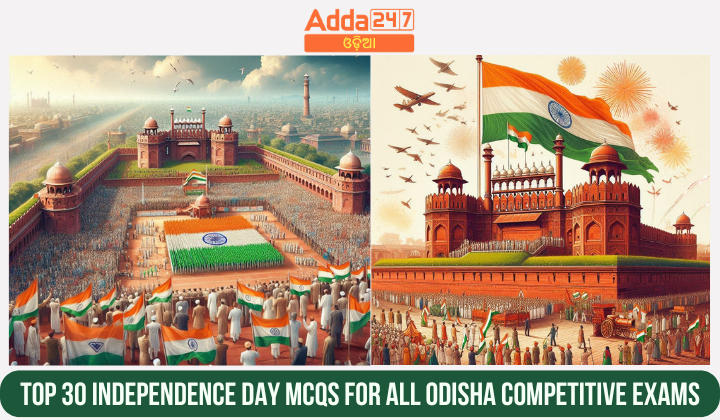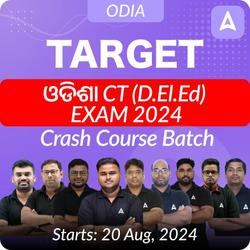Independence Day is a significant national holiday in India, celebrated annually on August 15th. It marks the end of British rule in 1947 and the birth of a free and independent India. This day commemorates the historic achievement of the Indian independence movement led by figures such as Mahatma Gandhi, Jawaharlal Nehru, and Sardar Patel. The day is celebrated with flag hoisting ceremonies, patriotic songs, and cultural programs across the country. The Prime Minister addresses the nation from the Red Fort in Delhi, highlighting the country’s achievements and future goals. Independence Day not only honors the sacrifices made by freedom fighters but also reflects on India’s progress and the values of democracy and freedom.
Top 30 Independence Day MCQs for All Odisha Competitive Exams
- When did India gain independence from British rule?
(a) August 15, 1945
(b) August 15, 1947
(c) August 15, 1949
(d) August 15, 1950
Ans: (b) August 15, 1947 - Who was the first Prime Minister of independent India?
(a) Mahatma Gandhi
(b) Sardar Patel
(c) Jawaharlal Nehru
(d) Dr. Rajendra Prasad
Ans: (c) Jawaharlal Nehru - Which event is associated with the Quit India Movement?
(a) 1920
(b) 1930
(c) 1942
(d) 1947
Ans: (c) 1942 - What was the name of the speech delivered by Jawaharlal Nehru on the eve of India’s independence?
(a) Tryst with Destiny
(b) The Dawn of Freedom
(c) India Awakes
(d) A New Dawn
Ans: (a) Tryst with Destiny - Which British Act led to the partition of India and the creation of Pakistan?
(a) Government of India Act 1935
(b) Indian Independence Act 1947
(c) Montagu-Chelmsford Reforms
(d) Rowlatt Act
Ans: (b) Indian Independence Act 1947 - Who was the last Viceroy of British India?
(a) Lord Mountbatten
(b) Lord Wavell
(c) Lord Curzon
(d) Lord Linlithgow
Ans: (a) Lord Mountbatten - What date was chosen to formally transfer power to India?
(a) August 15, 1946
(b) August 15, 1947
(c) August 15, 1948
(d) August 15, 1949
Ans: (b) August 15, 1947 - Which Indian leader is often referred to as the “Iron Man of India”?
(a) Subhas Chandra Bose
(b) Mahatma Gandhi
(c) Sardar Vallabhbhai Patel
(d) Bhagat Singh
Ans: (c) Sardar Vallabhbhai Patel - What was the original capital of British India before Delhi?
(a) Bombay
(b) Madras
(c) Calcutta
(d) Hyderabad
Ans: (c) Calcutta - Who was the British Prime Minister when India gained independence?
(a) Winston Churchill
(b) Clement Attlee
(c) Neville Chamberlain
(d) Harold Macmillan
Ans: (b) Clement Attlee - Where does the Prime Minister of India hoist the national flag on Independence Day?
(a) Rashtrapati Bhavan
(b) India Gate
(c) Red Fort
(d) Raj Ghat
Ans: (c) Red Fort - Which national anthem is played after the flag hoisting ceremony?
(a) Bande Mataram
(b) Saare Jahan Se Achha
(c) Jana Gana Mana
(d) Vande Mataram
Ans: (c) Jana Gana Mana - How many gun salutes are given during the Independence Day celebrations?
(a) 15
(b) 21
(c) 25
(d) 31
Ans: (b) 21 - Which ceremony marks the beginning of Independence Day celebrations at the Red Fort?
(a) Prime Minister’s Speech
(b) Guard of Honour
(c) National Anthem
(d) Flag Hoisting
Ans: (b) Guard of Honour - Who receives the Guard of Honour on Independence Day?
(a) The President
(b) The Vice President
(c) The Prime Minister
(d) The Chief Justice of India
Ans: (c) The Prime Minister - Which Indian leader famously said, “At the stroke of the midnight hour, when the world sleeps, India will awake to life and freedom”?
(a) Mahatma Gandhi
(b) Jawaharlal Nehru
(c) Dr. B.R. Ambedkar
(d) Sardar Vallabhbhai Patel
Ans: (b) Jawaharlal Nehru - What is the theme for the 78th Independence Day in 2024?
(a) Swachh Bharat
(b) Viksit Bharat
(c) Digital India
(d) Make in India
Ans: (b) Viksit Bharat - What does the saffron color in the Indian national flag represent?
(a) Peace and truth
(b) Courage and strength
(c) Fertility and growth
(d) Prosperity and wealth
Ans: (b) Courage and strength - Which color is in the middle band of the Indian national flag?
(a) Saffron
(b) White
(c) Green
(d) Blue
Ans: (b) White - What does the Ashoka Chakra in the Indian national flag represent?
(a) Justice
(b) Law and order
(c) Wheel of law
(d) National integrity
Ans: (c) Wheel of law - How many spokes are there in the Ashoka Chakra on the Indian national flag?
(a) 18
(b) 20
(c) 24
(d) 26
Ans: (c) 24 - Who designed the Indian national flag?
(a) Mahatma Gandhi
(b) Bhagat Singh
(c) Pingali Venkayya
(d) Sardar Patel
Ans: (c) Pingali Venkayya - What does the green color in the Indian national flag signify?
(a) Prosperity and fertility
(b) Wealth and power
(c) Strength and courage
(d) Peace and harmony
Ans: (a) Prosperity and fertility - In which year was the design of the current Indian national flag adopted?
(a) 1946
(b) 1947
(c) 1948
(d) 1949
Ans: (b) 1947 - Which act passed by the British Parliament led to India’s independence?
(a) Government of India Act 1935
(b) Indian Independence Act 1947
(c) Rowlatt Act
(d) Montagu-Chelmsford Reforms
Ans: (b) Indian Independence Act 1947 - Which Indian patriotic song, apart from the national anthem, is often sung during Independence Day celebrations?
(a) Vande Mataram
(b) Jana Gana Mana
(c) Saare Jahan Se Achha
(d) Kadam Kadam Badhaye Ja
Ans: (a) Vande Mataram - What is the significance of the 21-gun salute during Independence Day celebrations?
(a) To honor the national flag
(b) To honor the fallen soldiers
(c) To signify the country’s independence
(d) To signify the power of the nation
Ans: (c) To signify the country’s independence - Which Indian monument is a symbol of the country’s freedom struggle and is a focal point on Independence Day?
(a) India Gate
(b) Gateway of India
(c) Red Fort
(d) Raj Ghat
Ans: (c) Red Fort - What does the Ashoka Chakra in the center of the Indian national flag represent?
(a) Strength and courage
(b) The wheel of law and dharma
(c) Peace and prosperity
(d) Unity and integrity
Ans: (b) The wheel of law and dharma - On which date was the Indian national flag officially adopted by the Constituent Assembly of India?
(a) July 22, 1947
(b) August 15, 1947
(c) January 26, 1950
(d) December 10, 1947
Ans: (a) July 22, 1947
















